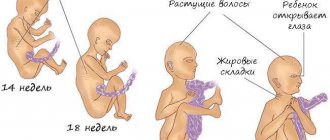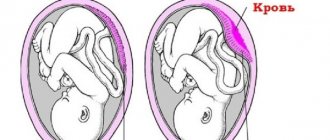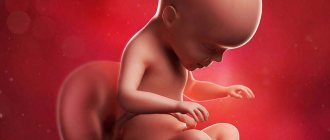Body changes and new sensations for women
The problem for some women in the second trimester may be excessive sweating - hyperhidrosis. The main causes of hyperhidrosis at week 22 are hormonal changes and an increase in the volume of fluid in the pregnant woman’s body due to increased uteroplacental blood flow. What should an expectant mother do to reduce sweat production and eliminate unpleasant odors? Choose bedding and clothing only from natural materials - synthetics are unacceptable for hyperhidrosis. Avoid coffee and spices - they can increase sweating because they have a stimulating effect on the central nervous system. Take a shower as often as possible, spend more time outdoors and be sure to ventilate the room in which you sleep. Read about the use of deodorants and antiperspirants during pregnancy below in our “Beauty and Accessories” section.
Feel
By 20-22 weeks, when the baby’s brain and spinal cord are fully formed, fetal movements become regular.
Primiparous women, as a rule, experience these sensations starting from the 20th week, at 22 they become more noticeable. Women carrying their second and third children detect movements much earlier, at 18 weeks. However, these deadlines may be different for everyone.
Primary movements are described differently by all women. They can be similar to the fluttering of a butterfly's wings, and some perceive them as intestinal peristalsis. But it is precisely this moment that doctors associate with the beginning of the unity of mother and child. A 5-month-old fetus can perform from 25 to 60 kicks within half an hour. Rhythm, movements, intensity change throughout the day.
Too much activity should alert a woman. Sometimes the fetal movements cause pain to the expectant mother. If this happens for more than half an hour, you should consult a doctor. Another warning sign is the absence of movement for more than 12 hours in a row.
Some women continue to experience a feeling of nausea, often turning into vomiting. This is Hyperemesis gravidarum, or a pregnancy complication that can last all 9 months. The exact causes of hyperemesis are unknown; they may have a genetic, hormonal basis, or it may be influenced by an increase in the level of estrogen in a woman’s body.
The second trimester is characterized by a change in eating habits. During this period, the baby’s active hematopoiesis “selects” all iron reserves from the mother’s body.
Lifestyle
At week 22, it is necessary to regularly unload the spine and strengthen the back with the help of special gymnastics for pregnant women. Here are some simple and safe exercises:
- Place one hand on your pubis, the other on your tailbone and gently move your pelvis back and forth for 2-3 minutes. Do the exercise several times a day.
- Get on all fours with emphasis on the palms of your hands and knees. Extend your right leg and make one circle with it, mentally counting to eight. Do the same exercise with your left leg.
- Sit on a fitball, straighten your back, put your hands on your hips, place your feet shoulder-width apart. Make circular movements with your pelvis on the ball - 5-6 “turns” in each direction.
If you feel unwell during exercise, immediately stop exercising, lie on your side and try to relax.
Fetal development
The 22nd week of pregnancy (many mothers capture photos of the belly during this period as a souvenir) is characterized by the formation of a baby’s “daily routine,” which does not quite coincide with the schedule of the expectant mother. Movements and fetal strokes bring a woman a feeling of happiness, but often occurring at night, they bring a feeling of fatigue and lethargy.
Changes that occur with the baby during this period:
- The child becomes more mature, his muscles develop, he already knows how to hold on to the umbilical cord, his movements become active and clear.
- The spine consists of intervertebral and vertebral discs, and the bones contain calcium.
- The first movements, called meconium, occur in the intestinal tract.
- The heartbeat is determined using a stethoscope.
- Nails grow to the tips of the fingers.
- Eyebrows and eyelashes develop, and eyelids also develop, although they may remain closed for up to 28 weeks.
- The eyes are fully formed, but the irises are still lacking color.
- Lips are forming.
- The legs and arms become proportional, but do not yet reach the desired size. He can clench and unclench his hands.
- The pancreas is formed and continues to mature.
- The intestines lengthen, bile is released, and the kidneys begin to secrete urine.
- The bronchi and lungs continue to develop.
- Lanugo, the primary hair, forms on the body, which disappears before birth, at 31 weeks. The reason for its appearance is still unclear, but doctors suspect that this is a necessary protection for the baby’s temperature. In some babies, the covering remains for 12 weeks after birth, which is typical for premature babies.
The length of the fetus during this period reaches 30–32 cm, weight is about 420–450 g. The perimeter of the skull is 162 mm, the diameter of the chest is 53 mm. At this stage of pregnancy, the fetus is already quite developed, but if suddenly the baby’s incubation is disrupted and premature birth begins, the baby can remain viable.
Beauty and accessories
Can I use deodorants and antiperspirants during pregnancy? Doctors recommend that women use natural deodorants - they do not contain alcohol, fragrances, aluminum salts or chemical additives, and therefore are absolutely harmless. Alum stone or alunite will also help get rid of unpleasant odors. This safe natural deodorant mineral blocks the activity of various microorganisms without leaving any traces on the body, while the sweat glands continue to work as before. As for antiperspirants, doctors do not allow treating areas of the skin with them during an “interesting situation” - they narrow the sweat ducts, thereby undermining the functioning of the kidneys and provoking the development of a variety of ailments and unpleasant sensations in pregnant women.
Fetus. Development at 22 weeks
Fetal development at 22 weeks
From the 22nd week of pregnancy, the process of increased fetal growth begins. By this time, he had already reached a length of 30 cm (from the top of his head to his toes) and a weight of about 0.5 kg. When a baby weighing 500 g is born, the chances of survival appear. But despite this, the baby is still very weak and not ready; premature birth at 22 weeks is accompanied by many problems with the child’s health. That is why the mother should closely monitor her health, trying to carry the fetus for the required 38-40 weeks.
This week the baby’s internal organs are already well formed and continue to master their functions. Development processes are most active in the nervous system. The brain weighs about 100 g, and the formation of new cells slows down. Neurons will appear, but much slower than before. During this period, the process of myelination of neurons continues: covering them with myelin to protect and increase the speed of signal transmission.
The fine-tuning of connections between nerve endings and command centers in the brain and spinal cord is not yet complete. Before the birth of the fetus, the nervous system must check and roll out all the necessary work options. At the 22nd week, the future baby already has different skills:
- analyze information coming from different parts of the body. This unconscious skill plays an important role in human development: innate reflexes - reaction to a stimulus;
- control movements (unconsciously). Incoming information about the stimulus activates innate reflexes: when the fetus touches the wall of the uterus with its leg, it will push away; when it hears a loud noise, it will throw up its arms; when it feels light, it will turn);
- grab an object that touches your hand;
- thumb sucking;
- hear and respond to light, sounds, sensations;
- distinguish between sweet and salty, bitter and sour;
- tumbling, kicking, thumping and flipping.
The fetus actively uses all these skills during periods of wakefulness. While the unborn baby sleeps most of the time (about 22 hours), waking up every 4 hours. Best of all, the expectant mother feels the movement of the fetus in the evening and at night, when it is quiet around and she goes to bed.
Many organs of the unborn child have started working and are training their functions. The gastrointestinal tract actively digests the amniotic fluid that the baby swallows. It contains sugar, water, hair particles, and epithelial cells. All this is digested in the stomach and passes into the intestines, where water and sugar are absorbed, and unnecessary materials are “stored” in the rectum. In the first days after birth, the baby will get rid of the accumulated original feces (meconium). The stool will be dark green or almost black, but mom doesn’t need to worry - this is its normal color.
The liver is actively involved in the digestion process. By processing and removing indirect bilirubin through the placenta, it protects the fetus from the harmful effects of this substance. In addition, the liver, together with the spleen, continues to take part in hematopoiesis.
Excess water is removed from the body by the kidneys through the urinary system. The baby pees directly into the amniotic fluid. But you shouldn’t be afraid of this, because the amniotic fluid is replaced several times a day.
The circulatory system actively delivers necessary nutrients to every cell of the body. The four-chambered heart works hard, making about 150 beats per minute. The cardiovascular system grows along with the unborn baby: the size of the heart gradually increases, new blood vessels are formed.
At 22 weeks, the fetal respiratory system is not yet developed enough for the baby to breathe outside the mother. Alveoli and bronchioles appear in the lungs, but there are still very few of them, and they are not ready to perform their functions. The lungs will be fully developed by the 32nd week of pregnancy, and the respiratory system will be ready by the 38th.
The replacement of cartilage tissue with bone tissue in the skeleton continues. The fetus consumes a lot of calcium, accumulating it in the bones. Ossification is most active this week in the spine (the base of the skeleton).
The amount of muscle tissue and fat increases. Thanks to this, the skin of the unborn baby becomes smoother, and previously existing wrinkles are gradually smoothed out. As a result, the fetus looks plumper, with a skin color close to natural.
A thin fluff (lanugo) is visible throughout the body of the unborn baby; on the head it is slightly larger and continues to grow. These hairs retain vernix lubrication on the fetal body and stimulate the development of hair follicles.
Vernix lubrication is a protective substance; it protects the baby’s delicate skin from the effects of amniotic fluid and maintains a constant body temperature. At the time of birth, it will help the fetus pass through the birth canal more easily. The only reminder of it will be a crust on the head, which will gradually wash off during the first months of life.
Changes in a woman’s body at 22 weeks of pregnancy
The body of a pregnant woman changes insignificantly; all the body’s forces are aimed only at maintaining the normal development of the embryo, giving it all the necessary substances and preparing for the upcoming birth. In some cases, this is not so easily tolerated; for this reason, attacks of simply ravenous hunger and dizziness occur. The fetus grows and develops every day, the baby’s weight increases, as does his height.
The volume of blood in the body of the expectant mother increases. In addition, it is worth noting that in this volume the number of aqueous lobe, erythrocytes and leukocytes increases unevenly. At approximately 22 weeks of pregnancy, the number of blood cells in the plasma is at its lowest. A lack of red blood cells, as well as hemoglobin, leads to anemia. It is very important to control this process and prevent anemia. To do this, a pregnant woman needs to eat as many foods rich in iron as possible (meat, for example) or take medications recommended by a doctor. The uterus does not stop growing, it raises other organs higher and higher, which naturally causes new and not always pleasant sensations. For example, this process can cause heartburn and other digestive problems. Numerous representatives of the fairer sex at 22 weeks of pregnancy experience difficulties with their gums, for example, soreness and bleeding. After the baby is born, everything should return to normal, but now you need to be careful when brushing your teeth.
At this stage, a pregnant woman can gain up to seven kilograms. 22 cm should be the height of the uterine fundus. At the same time, growth should be noticeable. If there is no increase, then this is a cause for concern and additional examinations.
What happens in the mother's body
22 weeks of pregnancy - how many months is it? This is 5.5 obstetric months, or a little more than five calendar months.
What happens to the mother at 22 weeks of pregnancy? The mother easily distinguishes between the periods of sleep and wakefulness of the child. As a rule, when the mother is active, the baby sleeps, and as soon as the woman wants to rest, he wakes up. This is explained by the rocking effect of the movements.
It's time to monitor your baby's motor activity. Of course, you shouldn’t worry and expect shocks every minute. It is enough to record the movements in the morning and evening. If the child does not move within 24 hours, you should immediately consult a doctor.
Some women expecting a baby for the first time are just now starting to feel movements. This is completely normal and should not cause concern.
The load on the kidneys increases, so edema may appear. Most often this is mild puffiness of the face and hands. Swelling in itself is not a reason to panic, since it does not pose a threat to either the woman or the baby. But they can be a sign of gestosis or late toxicosis, so if you notice such changes, you need to tell your doctor about it.
The most common complaint during this period is lower back pain. It is explained by the load that the spine experiences due to the growing and enlarged abdomen. The problem may not exist in women who played sports before pregnancy.
The most effective way to get rid of an unpleasant symptom is swimming. You can visit the pool up to 40 weeks, but it is better to discuss this issue with your doctor.
By mid-pregnancy, a decrease in hemoglobin levels is possible, especially if the patient did not eat properly in the earlier stages. This is explained by the growing need of the fetus for iron. According to WHO recommendations, the lower limit of normal hemoglobin in pregnant women is 110 g/l. Lower rates are a reason to review the diet and prescribe iron supplements. The dose of the medicine and duration of administration are regulated by the attending physician, under the control of a general blood test.
Vitamin deficiencies can cause small blood vessels to become very brittle. Outwardly, this manifests itself as bleeding from the nose and gums. Single episodes can be considered normal, but if the situation recurs, you should immediately inform your doctor.
The pregnant uterus compresses the veins of the small pelvis, increasing the likelihood of developing hemorrhoids - varicose veins of the rectum. Most often, the disease manifests itself as a painless protrusion in the anus. But sometimes it becomes painful, causing burning and discomfort. If you have such complaints, you should consult a proctologist - he will confirm the diagnosis and give the necessary recommendations. To prevent the disease, you need to prevent constipation, walk a lot, and wash yourself with cool water after visiting the toilet. To improve blood flow, it is advisable to stand in the knee-elbow position for 10–15 minutes every day. After childbirth, the disease may disappear, or more serious treatment may be required.
Vaginal discharge is mucous; a slight increase in its quantity is possible.
A new phenomenon at 22 weeks of pregnancy is Braxton-Hicks contractions. They are observed two to three times a day. At some point, the stomach becomes very tight, as if made of stone, and then relaxes. In this way, the uterus prepares for the upcoming birth.









